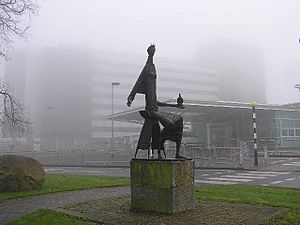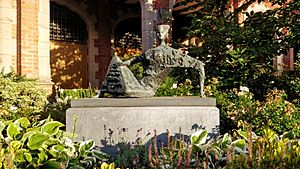F. E. McWilliam facts for kids
Quick facts for kids
F. E. McWilliam
|
|
|---|---|
| Born | 30 April 1909 Banbridge, County Down, Ireland
|
| Died | 13 May 1992 (aged 83) London, England
|
| Nationality | Northern Irish |
| Alma mater | Belfast College of Art, Slade School of Fine Art |
| Known for | Sculpture in stone, wood and bronze |
| Movement | Surrealism |
Frederick Edward McWilliam (born April 30, 1909 – died May 13, 1992) was a famous Northern Irish artist. He was a sculptor known for his unique style, often called surrealist. McWilliam mostly created his artworks from stone, wood, and bronze.
Contents
The Life of F. E. McWilliam
Frederick Edward McWilliam was born in Banbridge, County Down, which is in Ireland. His father, Dr. William McWilliam, was a local doctor. Growing up in Banbridge had a big impact on his art. He often mentioned local craftspeople, like furniture makers, in his letters.
Becoming a Sculptor
McWilliam first went to Campbell College in Belfast. Then, in 1926, he studied at the Belfast College of Art. In 1928, he moved to London to study at the Slade School of Fine Art.
He originally wanted to be a painter. However, he met Henry Moore, another famous sculptor, and was inspired by A.H. Gerrard, who taught sculpture at Slade. These influences made him decide to become a sculptor instead. He even traveled to Paris to visit the studio of Constantin Brâncuși, a very important sculptor.
War and Teaching
During the Second World War, McWilliam joined the Royal Air Force. He spent four years in England, where he helped by looking at aerial photos. Later, he was sent to India. There, he taught art at the Hindu Art School in New Delhi.
After the war, he returned home. He taught art for a year at the Chelsea School of Art. Then, his former teacher, A. H. Gerrard, invited him to teach sculpture at the Slade School. He taught there until 1968.
Famous Artworks and Recognition
The 1950s were a busy time for McWilliam. He received many important requests to create sculptures. One of his well-known works, the Four Seasons Group, was made for the Festival of Britain in 1951. In 1957, he created a large sculpture called Princess Macha for Altnagelvin Hospital in Derry.
During a difficult time in Northern Ireland known as the Troubles, McWilliam created a series of bronze sculptures. These were called Women of Belfast (1972–73). He made them after a bombing at the Abercorn Tea-Rooms. This series showed his response to the events happening around him.
McWilliam received many honors for his work. In 1964, Queen's University Belfast gave him an honorary Doctor of Letters degree. In 1966, he was awarded the CBE. He also won the Oireachtas Gold Medal in 1971. His sculptures are now in many public art collections, including the MOMA in New York and Tate Britain in London.
In 1981, the Arts Council of Northern Ireland held a special show of his work. Another big show was held at the Tate Gallery in 1989 to celebrate his 80th birthday.
McWilliam continued to create sculptures until he passed away from cancer in London on May 13, 1992.
McWilliam's Style
McWilliam's art often featured human figures. He would shape them into unusual or twisted positions. His style is often described as modern and surreal. Surrealism is an art movement that uses dream-like images and unexpected combinations.
In September 2009, a special art gallery and studio opened in Banbridge. It is dedicated to McWilliam's work and named after him.
See also
- List of Northern Irish artists



